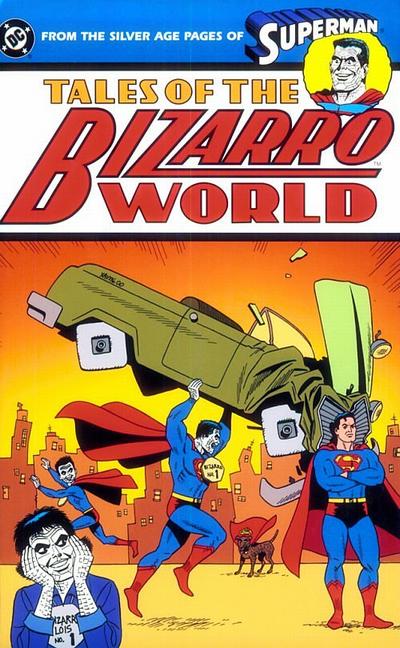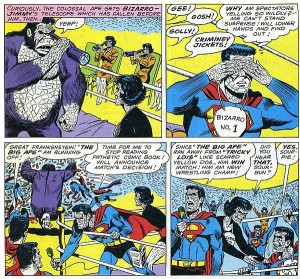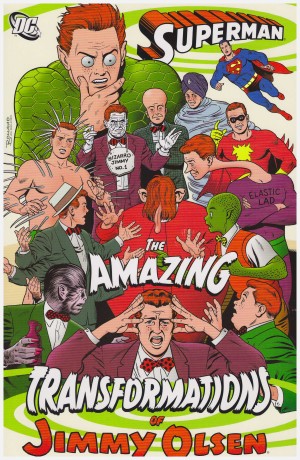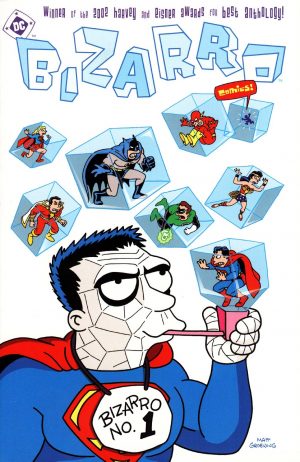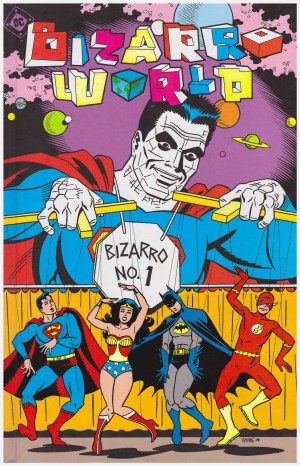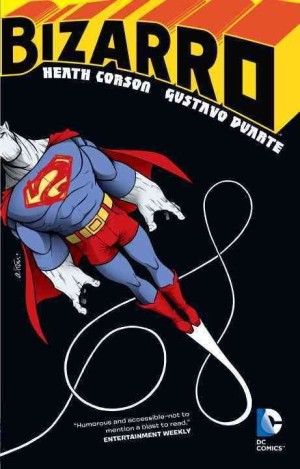Review by François Peneaud
Bizarro, the imperfect double of Superman, is one of his few adversaries who starred in a solo series early on. Created in 1958, his own series began three years later, and it’s collected in this book, which boasts a cover by Jaime Hernandez.
Set on the famous 1960s version of Bizarro’s world, a cubic world peopled with imperfect copies of Superman and Lois Lane, these tales are far removed from the moralising tone of superhero comics of the time: here, zany humor is given free reign.
Each episode, written by Jerry Siegel and drawn by John Forte (except for the first, by Superman stalwart Wayne Boring), opens with a page showing some differences between this world and ours (“cold dogs” instead of “hot dogs”, pedestrians honking to cross the road, the winner of a race being the last runner…). The main theme is using nonsense to gently mock tropes of Superman and his supposedly perfect world. An early tale has fun with the idea of Superman having a secret identity as Bizarro decides to become a journalist, has himself called “Bizarro Kent”, only to be uncovered a few panels later. In hindsight, there’s something of the self-reflexive in that story, almost fodder for academic thought. To be honest, not all the stories display that quality.
The trigger is often the presence of a Bizarro-ed character like Mr. Mxyzpltk (an imp with magic powers), Titano (a giant ape), or of one of the original characters. Such is Jimmy Olsen who, after having been kidnapped by Bizarro, has a hard time figuring out the logic of those people.
The mechanism of reversal is often used. Bizarro Luthor, for example, is a nice inventor who can never use his inventions to benefit others. Elsewhere the creation of a Bizarro caveman produces a handsome, intelligent man named Sapollo (“sap”+”Apollo”?) who quickly realises he doesn’t belong in Bizarro’s world, thus adding a little something to the often simple humor. His inability to fit in among the other Bizarros is due to them hating everything that’s perfect, a counterexample of the conformism of our own society. The cubic world might be the polar opposite of ours, but it is in many ways the faithful reflection of our mores.
The idea of the reflection, of the mirror-images, is of course reminiscent of the world of Alice in Wonderland. Bizarro might look like a Frankenstein’s creature, but he behaves like someone from a modern fairytale. The big, cubic world is in fact a deep, round hole. That being said, the superficial look of zaniness hides a 1950s social orthodoxy that becomes obvious when one realises that most Bizarros and their wives look and behave exactly alike. The satirical vision has its limits: only the final material sees an inversion of some male/female social roles, the epitome of the conformity of the times.
Forte provides solid pages, much in the manner of the DC house style, which did not leave much room for variety, so Forte does what’s expected of him. In that sense the art is the opposite of the stories, which try to be absurd and unpredictable–without always succeeding, it must be said.
Tales of the Bizarro World is a good example of off-kilter mainstream comics from yesteryear. The stories are not a lost masterpiece, but they stand out well enough from the superhero crowd to deserve this collection.
